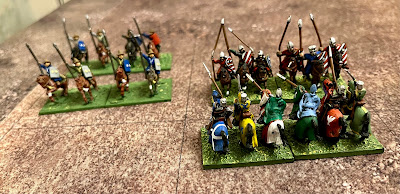My current bedtime reading is Cypria, a history of Cyprus by Alex Christofi. It reminded me of a little-known excursion Richard the Lionheart made to Cyprus on his way to Acre and the Third Crusade.
The Third Crusade (1189–1192) was launched to recapture Jerusalem, which had fallen to Saladin in 1187. Richard I and Philip II of France journeyed to the Holy Land by sea. Richard had already stopped off in Sicily and dabbled in the local politics there before sailing for Acre with a fleet of 150 ships and 53 galleys.
In April 1191, Richard’s fleet encountered a storm near Cyprus. Several ships, including one carrying his fiancée, Berengaria of Navarre, and his sister, Joan of England, were blown off course and landed on the island. Cyprus was controlled by Isaac Komnenos, a Byzantine nobleman who had declared himself Emperor of the island. Isaac seized the opportunity to capture some shipwrecked Crusaders and their supplies. Richard unsurprisingly decided to intervene and landed at Limassol on May 6, 1191. He viewed the island as a helpful resource and a strategic base for the Crusade. The English chronicler Benedict of Peterborough says, "Then in great wrath, he sent messengers to the Emperor of Cyprus, once, twice, and yet a third time, making his request with mild entreaty, that his fellow pilgrims, whom the Emperor was keeping in durance, should be restored to him together with their belongings. To whom the Emperor made answer with proud words, refusing to surrender either the prisoners or their belongings, and saying that he had no fear of the king of England or of his threats."
 |
| Limassol Castle today |
The concept of Richard making a 'mild entreaty' is unlikely! Richard's forces quickly overwhelmed the defenders at Limassol in a contested amphibious landing. Many of the local nobility and merchants, dissatisfied with Isaac's oppressive rule, submitted to Richard, bolstering his position. Isaac initially conceded defeat and even promised to join the Crusade. However, he then retreated into the interior, hoping to rally resistance. Richard sailed around to the north of the island, leaving Guy of Lusignan in command of the army to pursue Issac. It is unclear how many actions were fought, but the evidence points to at least one significant battle, and Richard did capture the main castles. This included St Hilarion Castle, which was no mean feat. Just climbing to the top was enough for me.
Isaac eventually surrendered after being promised lenient treatment. Richard honoured his word but added a twist: Isaac was imprisoned in silver chains, as he had requested not to be shackled in iron. Richard sold the island to the Knights Templar later in 1191, who then resold it to Guy of Lusignan, the deposed King of Jerusalem, establishing the Kingdom of Cyprus. A vital stronghold for Christian powers in the Eastern Mediterranean for centuries.
This story formed the basis for our midweek game of To the Strongest in 15mm. The Crusader army lists work fine for Richard's forces. We used the later Byzantine Komenean list for Issac. The chroniclers mention men at arms and Turcoples, but there must have been local spearmen.
The battle initially went well for Richard, who seized the high ground in the centre and made good progress on the left wing.
However, the Byzantines rallied and, with some impressive shooting on the right, managed to win the game with one victory point left.
A good, close game and an interesting bit of history.





No comments:
Post a Comment